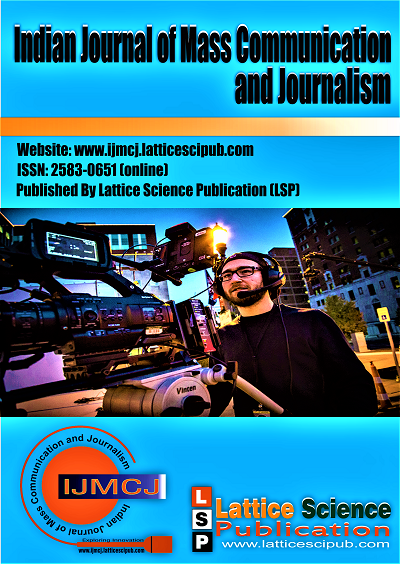The Development of Journalism in the Face of Social Media - A Study on Social Media’s Impact on a Journalist’s Role, Method, and Relationship to the Audience
Main Article Content
Abstract
This article explores how social media has changed journalism, with a particular emphasis on how it has affected reporters' roles, techniques, and interactions with audiences. Social media sites like Facebook, Instagram, and Twitter have given journalists new opportunities as well as difficulties [1]. These platforms' introduction has sped up news cycles and moved the emphasis from in-depth reporting to quick, snappy content creation [2]. As a result of this change, journalists must learn to work in a faster-paced news environment and handle the challenges of information overload and source verification [vi]. Both qualitative and quantitative research methodologies are used in this study. Ten journalists participated in in-depth interviews to collect qualitative data, which showed how social media has drastically changed traditional reporting practices by requiring a balance between accuracy and speed [12]. The spread of false information and the pressure to give sensationalism top priority in order to achieve high engagement metrics have been identified as major obstacles [13]. Variations in the frequency of audience interaction, the number of platforms used, and the reliance on social media for news sourcing are highlighted by quantitative analysis based on surveys of 250 journalists. According to the research, social media is heavily relied upon by journalists, with 27.2% of them utilising it for 41–60% of their news sourcing and differing degrees of audience interaction. "The ethical ramifications of social media in journalism are also examined in the study.'' While some journalists discover that social media improves audience engagement and speeds up the distribution of news, others worry about the detrimental effects on journalistic ethics and integrity. According to the study's findings, social media can increase interaction and immediacy, but it can also make it difficult to uphold ethical standards and accuracy.
Downloads
Article Details

This work is licensed under a Creative Commons Attribution-NonCommercial-NoDerivatives 4.0 International License.
How to Cite
References
Adornato, A. C. (2016). Forces at the Gate: Social media’s influence on editorial and production decisions in local television newsrooms. Electronic News, 10(2), 87-104, https://doi.org/10.1177/1931243116647768
Angelo (2019). Social Media: Positive and Negative Effects on Journalism. DOI: https://medium.com/@angelomosco/social-media-positive-negativeeffects-on-journalism-d99bda197787
Raghav Kumar Jha (2023). Social Media Revolution in Journalism & Its Impact on the Future of Mainstream Media: A Critical Analysis. International Journal for Multidisciplinary Research (IJFMR). Volume 5, Issue 2. https://www.ijfmr.com/papers/2023/2/1843.pdf https://doi.org/10.36948/ijfmr.2023.v05i02.1843
Hudson, E. (2017). The pros and cons of citizen journalism on social media. Retrieved from Medium. DOI: https://medium.com/@hudson.elliemay/the-pros-and-cons-of-citizenjournalism-in-social-media-6c351b16ff2c
ING News (2015). Social media has a growing impact on the news #SMING15, Amsterdam. Available at: ING. DOI: https://www.ing.com/Newsroom/All-news/Social-media-has-agrowing-impact-on-the-news-SMING15.htm
Johnston, L. (2016). Social News = Journalism Evolution? How the integration of UGC into news work helps and hinders the role of the journalist. Digital Journalism, 4(7), pp. 899-909, https://doi.org/10.1080/21670811.2016.1168709
Kuyucu, Mihalis. (2020). Social media and journalism. Available at: ResearchGate. https://www.researchgate.net/publication/348135473_Social_Media_and_Journalism
Lewis, S., & Molyneux, L. (2018). A Decade of Research on Social Media and Journalism: Assumptions, Blind Spots, and a Way Forward. Media and Communication, 6(4), 11-23. https://doi.org/10.17645/mac.v6i4.1562
Lin, M. (2017). Social media journalism: pros and cons of Twitter. Available at: Mulinblog. file:///C:/Users/shivk/Downloads/FullMakalesimliKapakl.pdf
Matthias Degen, Max Olgemöller, & Christian Zabel (2024) Quality Journalism in Social Media: What We Know and Where We Need to Dig Deeper, Journalism Studies, 25:4, 399-420. Doi: https://doi.org/10.1080/1461670X.2024.2314204
McGregor, S. C., & Molyneux, L. (2016). Twitter’s influence on news judgement: An experiment among journalists. Journalism. DOI: https://doi.org/10.1177%2F1464884918802975
Molyneux, L. & Mourão, R. R. (2017). Political journalists’ normalisation of Twitter: interaction and new affordances. Journalism Studies. DOI: https://doi.org/10.1080/1461670X.2017.1370978
Nielsen, R. K., & Ganter, S. A. (2017). Dealing with digital intermediaries: A case study of the relations between publishers and platforms. New Media and Society. DOI: https://doi.org/10.1177%2F1461444817701318
Robinson, S. (2010), ‘Traditionalists vs. Converges: textual privilege, boundary work, and the journalist-audience relationship in the commenting policies of online news sites. Convergence: The International Journal of Research into New Media Technologies, 16(1):125–143. https://doi.org/10.1177/1354856509347719
Russell, F. M. (2017). Twitter and news gatekeeping: Interactivity, reciprocity, and promotion in news organisations’ tweets. Digital Journalism. DOI: https://doi.org/10.1080/21670811.2017.1399805
Safori, Amjad. (2018). Social media's impact on a journalist's role. Journal of Science Education. 19. 148-162. Available at: ResearchGate. https://www.researchgate.net/publication/329416333_Social_Media's_Impact_on_a_Journalist's_role
Steensen, S. (2011), ‘Cosy Journalism’, Journalism Practice, 5:6, 687-703. https://doi.org/10.1080/17512786.2011.604243
Thorsen, E., & Jackson, D. (2018). Seven characteristics defining online news formats: toward a typology of online news and live blogs. Digital Journalism. DOI: https://doi.org/10.1080/21670811.2018.1468722
Usher, N., Holcomb, J., & Littman, J. (2018.) Twitter makes it worse: Political journalists, gendered echo chambers, and the amplification of gender bias. The International Journal of Press/Politics. DOI: https://doi.org/10.1177%2F1940161218781254
Witschge, T., Anderson, C. W., Domingo, D., & Hermida, A. (2018). Dealing with the mess (we made): Unravelling hybridity, normativity, and complexity in journalism studies. Journalism. DOI: https://doi.org/10.1177%2F1464884918760669
Srivastava, A., & Saxena, Dr. U. K. (2023). Digital Media and Media literacy. An Analysis of the Contribution and Effect of social media in Media Literacy. In Indian Journal of Mass Communication and Journalism (Vol. 3, Issue 1, pp. 17–22). https://doi.org/10.54105/ijmcj.a1051.093123
Nurhadi, Burhanuddin Tola, Riyadi, Emotional Instruments on Reading Novel using Social Media Among Indonesian Students. (2019). In International Journal of Recent Technology and Engineering (Vol. 8, Issue 3S2, pp. 515–519). https://doi.org/10.35940/ijrte.c1117.1083s219
Sinha, P., & Kumar, K. A. (2020). REST APIs for Emerging Social Media Platforms. In International Journal of Innovative Technology and Exploring Engineering (Vol. 9, Issue 5, pp. 652–659). https://doi.org/10.35940/ijitee.e2608.039520
Joshi, S. C., Gupta, K., & Manektala, S. (2022). Misinformation, Public Opinion, and the Role of Critical Thinking. In International Journal of Management and Humanities (Vol. 8, Issue 9, pp. 15–18). https://doi.org/10.35940/ijmh.i1483.058922
Satpathy, S., & Patnaik, Dr. S. (2021). Role of Artificial Intelligence in Social Media and Human Behaviour. In International Journal of Engineering and Advanced Technology (Vol. 11, Issue 1, pp. 207–210). https://doi.org/10.35940/ijeat.a1926.1011121





